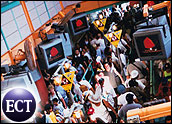
Interactive marketing has come a long way. In 2005 it will appear more often not only on the big screen — the computer screen, that is — but on the little screen of the mobile phone as well. With a cell phone the constant companion to more than 170 million Americans, there’s a lot of potential.
A marketing phenomenon that already has achieved great popularity in Europe and South Africa is now catching on with North American marketers, who see a benefit in reaching customers when they’re out spending money.
Overall, digital media and technology enable marketers to better target potential customers. And it often registers responses better than traditional marketing efforts, pleasing company executives and shareholders who want to see accountability for every dollar spent on a brand.
Moving Targets
According to soon-to-be-released research from the CMO Council and the Promotion Marketing Association — titled “Digital Directions: How Technology Is Touching and Transforming Promotions” — 19.8 percent of marketers across industries have used or are considering using short message service (SMS).
“Mobile marketing is quickly becoming the most direct, most interactive, widest-reaching and fastest-growing marketing medium in the world,” said Barrie Arnold, vice president of strategy and business development for SMS Media Group of Aliso Viejo, Calif.
SMS Media Group drops sponsorship or advertising onto permission-based SMS content like daily horoscopes or winning lottery number alerts. It also conducts straight mobile marketing campaigns. By requiring an opt-in from consumers before sending advertising to their cell phones, the company builds a unique subscriber base for each product. Macy’s, for instance, can choose to sponsor messages only to women, aged 18 to 35, who earn more than $40,000 annually and live within 25 miles of a Macy’s store.
There are countless ways to segment a customer group. A chemical company might notify its farming customers when to spray their crops according to the climate and weather of particular geographical pockets, and afterward, remind them to order more product. A pharmacy can send SMS messages to senior citizens when they need to refill their prescriptions. CNET already notifies consumers when the electronic items they want drop in price.
Younger Consumers
“It’s lifestyle marketing triggered by an event,” said Donovan Neale-May, executive director of the CMO Council.
SMS marketing inexpensively notifies customers of a promotion when they’re out and about, spending money, “not when they get back to their houses and … and turn on their computer and log into their e-mail,” he said.
That said, the messages must be relevant or they won’t elicit a reponse, both Neale-May and Arnold said. Relevancy is especially important in the United States, where recipients pay 5 cents or 10 cents for each text message. In other parts of the world, service contracts tend not to operate on a per-message basis.
More than 30 billion text messages were sent in the United States in 2004, Arnold said, and most originated with 12- to 34-year-olds who influence or account for more than $800 billion in annual spending.
Aggregated data from eMarketer indicates that younger wireless users are more receptive to mobile advertising than those ages 35 and up. Respondents surveyed for the “Digital Directions” study expected college students to respond most readily (79.7 percent), followed by teenagers (75.2 percent), males 18-34 (62.2 percent) and youth (58.1 percent).
“Their whole social fabric is driven by their mobile connections,” Neale-May said of young consumers.
Investing in Mobile Marketing
“Clients buying media in our mobile media network are experiencing 4 percent or better response rates,” said Tom Burgess, CEO of Third Screen Media of Waltham, Mass., a mobile advertising vendor.
Dunkin’ Donuts (which is not a Third Screen Media client) achieved a 4 percent response to a mobile coupon it distributed to young adults in Boston, for example. Short codes and similar solutions give marketers a way to track success.
In late February, the Mobile Marketing Association established committees to compile return-on-investment (ROI) metrics and best practices for mobile CRM. The association said in a statement that by the end of the year it should have the information on which to base guidelines for mobile marketing campaigns.
SMS Media’s Arnold admitted that mobile marketing can be as difficult to measure as traditional media advertising, unless marketers direct message recipients to a specific URL or code a direct-response message or provide people with vanity phone numbers to call. There is technology to do this, but its application costs money.
The average Third Screen Media client has budgeted between $25,000 and $250,000 for mobile marketing this year, reported Burgess. But influencing consumers never comes without a cost.














































Social CRM
See all Social CRM